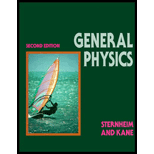
Concept explainers
(a)
To show the potential at a point on its axis at a distance
(a)
Answer to Problem 81E
The potential at a point on its axis at a distance
Explanation of Solution
The below figure (1) shows a uniformly charged disk of radius

The electric potential at a point
Here,
The potential
Integrate the Equation (I),
Conclusion:
Take
As
Therefore, the potential at a point on its axis at a distance
(b)
To show the potential
(b)
Answer to Problem 81E
The expression for the electric potential due to the point charge is
Explanation of Solution
From part (a),
The potential at a point on its axis at a distance
Conclusion:
If
Using binomial expansion,
The expression for the electric potential due to the point charge is
Want to see more full solutions like this?
Chapter 16 Solutions
General Physics, 2nd Edition
- A CD disk of radius (R = 3.0 cm) is sprayed with a charged paint so that the charge varies continually with radial distance r from the center in the following manner =(6.0C/m)r/R ?. Find the potential at a point 4 cm above the center.arrow_forwardIs the electric potential necessarily constant over the surface of a conductor?arrow_forwardIf a negatively charged particle is placed at rest in an electric potential field that increases in the positive x-direction, will the panicle (a) accelerate in the positive x-direction, (b) accelerate in the negative x-direction, or (c) remain at rest?arrow_forward
- The three charged particles in Figure P20.11 are at the vertices of an isosceles triangle (where d = 2.00 cm). Taking q = 7.00 C, calculate the electric potential at point A, the midpoint of the base. Figure P20.11arrow_forwardWhen a potential difference of 150. V is applied to the plates of an air-filled parallel-plate capacitor, the plates carry a surface charge density of 3.00 1010 C/cm2. What is the spacing between the plates?arrow_forwardTwo very large metal plates are placed 2.0 cm apart, with a potential difference of 12 V between them. Consider one plate to be at 12 V, and the other at 0 V. (a) Sketch the equipotential surfaces for 0, 4, 8, and 12 V. (b) Next sketch in some electric field lines, and confirm that they are perpendicular to the equipotential lines.arrow_forward
- When a potential difference of 150. V is applied to the plates of an air-filled parallel-plate capacitor, the plates carry a surface charge density of 3.00 1010 C/cm2. What is the spacing between the plates?arrow_forwardFour particles are positioned on the rim of a circle. The charges on the particles are +0.500 C, +1.50 C, 1.00 C, and 0.500 C. If the electric potential at the center of the circle due to the +0.500 C charge alone is 4.50 104 V, what is the total electric potential at the center due to the four charges? (a) 18.0 104 V (b) 4.50 104 V (c) 0 (d) 4.50 104 V (e) 9.00 104 Varrow_forwardA proton is released from rest at the origin in a uniform electric field in the positive x direction with magnitude 850 N/C. What is the change in the electric potential energy of the protonfield system when the proton travels to x = 2.50 m? (a) 3.40 1016 J (b) 3.40 1016 J (c) 2.50 1016 J (d) 2.50 1016 J (e) 1.60 1019 Jarrow_forward
- A filament running along the x axis from the origin to x = 80.0 cm carries electric charge with uniform density. At the point P with coordinates (x = 80.0 cm, y = 80.0 cm), this filament creates electric potential 100 V. Now we add another filament along the y axis, running from the origin to y = 80.0 cm. carrying the same amount of charge with the same uniform density. At the same point P, is the electric potential created by the pair of filaments (a) greater than 200 V, (b) 200 V, (c) 100 V, (d) between 0 and 200 V, or (e) 0?arrow_forwardThe two charges in Figure P16.12 are separated by d = 2.00 cm. Find the electric potential at (a) point A and (b) point B, which is hallway between the charges. Figure P16.12arrow_forwardIt is shown in Example 24.7 that the potential at a point P a distance a above one end of a uniformly charged rod of length lying along the x axis is V=keQlln(l+a2+l2a) Use this result to derive an expression for the y component of the electric field at P.arrow_forward
 Physics for Scientists and EngineersPhysicsISBN:9781337553278Author:Raymond A. Serway, John W. JewettPublisher:Cengage Learning
Physics for Scientists and EngineersPhysicsISBN:9781337553278Author:Raymond A. Serway, John W. JewettPublisher:Cengage Learning Physics for Scientists and Engineers with Modern ...PhysicsISBN:9781337553292Author:Raymond A. Serway, John W. JewettPublisher:Cengage Learning
Physics for Scientists and Engineers with Modern ...PhysicsISBN:9781337553292Author:Raymond A. Serway, John W. JewettPublisher:Cengage Learning
 College PhysicsPhysicsISBN:9781285737027Author:Raymond A. Serway, Chris VuillePublisher:Cengage Learning
College PhysicsPhysicsISBN:9781285737027Author:Raymond A. Serway, Chris VuillePublisher:Cengage Learning College PhysicsPhysicsISBN:9781305952300Author:Raymond A. Serway, Chris VuillePublisher:Cengage Learning
College PhysicsPhysicsISBN:9781305952300Author:Raymond A. Serway, Chris VuillePublisher:Cengage Learning Physics for Scientists and Engineers, Technology ...PhysicsISBN:9781305116399Author:Raymond A. Serway, John W. JewettPublisher:Cengage Learning
Physics for Scientists and Engineers, Technology ...PhysicsISBN:9781305116399Author:Raymond A. Serway, John W. JewettPublisher:Cengage Learning





